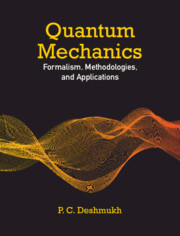Book contents
- Frontmatter
- Dedication
- Contents
- List of Figures
- Foreword
- Preface
- 1 Description of a Physical System
- 2 Path Integral Formulation of Quantum Mechanics
- 3 Probability Tangles and Eigenstates of One-dimensional Potentials
- 4 Angular Momentum
- 5 The Non-relativistic Hydrogen Atom
- 6 Approximation Methods
- 7 The Relativistic Hydrogen Atom
- 8 Quantum Mechanics of Spectral Transitions
- 9 The Many-Electron Atom
- 10 Quantum Collisions
- 11 Introduction to Quantum Information and Quantum Computing
- Appendix A Symmetry of the Hamiltonian
- Appendix B Schrödinger, Heisenberg, and Dirac “Pictures” of Quantum Dynamics
- Appendix C Spherical Harmonics
- Appendix D Occupation Number Formalism Second Quantization
- Appendix E Electron Structure Studies with Qubits
- Index
Appendix D - Occupation Number Formalism Second Quantization
Published online by Cambridge University Press: 14 September 2023
- Frontmatter
- Dedication
- Contents
- List of Figures
- Foreword
- Preface
- 1 Description of a Physical System
- 2 Path Integral Formulation of Quantum Mechanics
- 3 Probability Tangles and Eigenstates of One-dimensional Potentials
- 4 Angular Momentum
- 5 The Non-relativistic Hydrogen Atom
- 6 Approximation Methods
- 7 The Relativistic Hydrogen Atom
- 8 Quantum Mechanics of Spectral Transitions
- 9 The Many-Electron Atom
- 10 Quantum Collisions
- 11 Introduction to Quantum Information and Quantum Computing
- Appendix A Symmetry of the Hamiltonian
- Appendix B Schrödinger, Heisenberg, and Dirac “Pictures” of Quantum Dynamics
- Appendix C Spherical Harmonics
- Appendix D Occupation Number Formalism Second Quantization
- Appendix E Electron Structure Studies with Qubits
- Index
Summary
We might say that the three operators a†, a and n = a†a correspond respectively to the Creator (Brahma), the Destroyer (Shiva), and the Preserver (Vishnu) in Hindu mythology.
—J. J. Sakurai in Advance Quantum MechanicsThe aforementioned remark by Sakurai may be taken in a lighter vein. When we consider matter energy conversion, it does become essential to introduce operators for particle creation and annihilation. We will, however, introduce them in this appendix with a limited objective, to indicate their efficacy in going beyond the Hartree–Fock (HF) self-consistent field (SCF) method (Chapter 9). It would prepare the readers to tackle problems involving a many-electron system going beyond the single-particle approximation, also referred to as the Independent Particle Approximation (IPA). The mathematical machinery we employ to achieve this is the occupation number formalism. Also, it will familiarize the reader with basic tools introduced in Appendix E to solve the quantum mechanical many-electron problem on a quantum computer (Chapter 11). Much of the occupation number formalism was developed by Jordan and Wigner [1, 2].
D.1 Creation and Annihilation Operators
In Chapter 1, we introduced “quantization” as a mathematical framework to describe the laws of nature in a consistent and successful manner. Essentially, it encompassed dispensing with the classical description of a system in terms of the dynamical variables q and p, and replacing them by operators qop and pop. These operate on wavefunctions, which are coordinate representations of state vectors in a Hilbert space. The resulting mathematical contraption initially seemed abstract, but unlike the classical description, it provides a suitable and beneficial description of nature. Quantization leads to discrete energy eigen-spectra when boundary conditions on the differential (Schrödinger) equation are appropriate for bound-states of the physical system under study, as well as to an energy continuum in the case of unbound states. When a bound state and a continuum state are degenerate, and both are accessible to the system, one has meta-stable states (resonances) which may decay (autoionization) into separate fragments of the system. Such a process can also be described as annihilation of a particle in a discrete level and creation of the same in a continuum eigenstate. In particular, the description of atomic photoionization (Section 6.3, Chapter 6) as well as that of an autoionization resonance benefits from a reformulation in terms of annihilation and creation operators.
Information
- Type
- Chapter
- Information
- Quantum MechanicsFormalism, Methodologies, and Applications, pp. 594 - 606Publisher: Cambridge University PressPrint publication year: 2024
